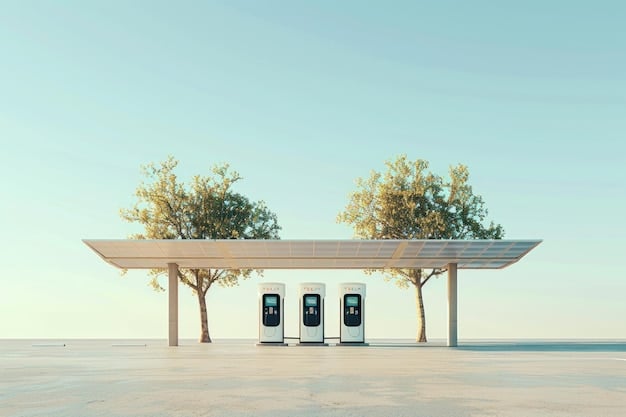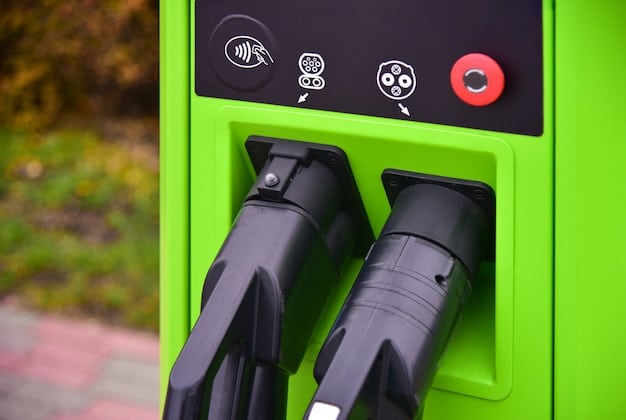Electric Vehicle Infrastructure Bill: Where Does the $7.5 Billion Go?

The Electric Vehicle Infrastructure Bill allocates $7.5 billion to expand the electric vehicle charging infrastructure across the United States, aiming to make EV adoption more accessible and convenient for all Americans.
The Electric Vehicle Infrastructure Bill Update: $7.5 Billion Investment in Electric Vehicle Charging Stations – Where Will the Money Go? is a pivotal moment for the electric vehicle (EV) industry, setting the stage for a significant expansion of charging infrastructure across the United States. This investment aims to address a key barrier to EV adoption: range anxiety and the lack of convenient charging options.
Unpacking the Electric Vehicle Infrastructure Bill
The Electric Vehicle Infrastructure Bill is a critical component of the broader Bipartisan Infrastructure Law, earmarking substantial funds to support the build-out of a national EV charging network. This initiative not only targets the quantity of charging stations but also focuses on strategic placement and reliability.
Key Objectives of the Bill
The primary goal is to establish a convenient, reliable, and affordable charging network throughout the country. This includes:
- Creating a standardized charging experience across different states.
- Installing chargers in rural and underserved communities.
- Ensuring that charging stations are accessible and user-friendly.
The bill also aims to promote job creation in the manufacturing, installation, and maintenance of EV charging equipment.

Ultimately, the Electric Vehicle Infrastructure Bill intends to accelerate the transition to electric vehicles by making charging infrastructure more accessible and efficient.
The $7.5 Billion Investment: A Detailed Breakdown
The $7.5 billion allocated by the Electric Vehicle Infrastructure Bill has a multifaceted distribution plan. Understanding where this money is going is crucial for grasping the scope and impact of the initiative.
Here’s a breakdown of how the funds are being allocated:
- $5 Billion for the National Electric Vehicle Infrastructure (NEVI) Formula Program: This program provides funds to states to deploy EV chargers along designated Alternative Fuel Corridors.
- $2.5 Billion for Discretionary Grants: These grants support community-led projects and innovative approaches to EV charging.
In addition, a portion of the funds is set aside for workforce development and technical assistance to ensure a skilled workforce is available to support the expanding EV charging network.
NEVI Formula Program: Charging Across America
The National Electric Vehicle Infrastructure (NEVI) Formula Program is the cornerstone of the EV charging infrastructure expansion, providing funds directly to states based on a formula that considers population size and other relevant factors.
States are required to submit plans outlining how they intend to use these funds, with a focus on:
- Building charging stations along Alternative Fuel Corridors.
- Ensuring chargers meet minimum standards for reliability and accessibility.
- Supporting community engagement and public awareness campaigns.
Challenges in Implementation
Implementation challenges include coordinating across state lines, navigating permitting processes, and ensuring equitable access to charging in underserved communities.
Discretionary Grant Programs: Innovation and Community Engagement
In addition to the NEVI Formula Program, the Electric Vehicle Infrastructure Bill includes discretionary grant programs that support innovative approaches to EV charging and community-led projects. These grants are designed to foster creativity and address specific needs within local communities.

These grant programs prioritize projects that:
- Deploy EV chargers in rural and underserved areas.
- Support innovative charging solutions, such as mobile charging stations.
- Promote community engagement and public awareness about EVs.
These programs provide the flexibility needed to address unique challenges and opportunities in different regions of the country.
Impact on Consumers and the EV Market
The expansion of EV charging infrastructure is expected to have a significant impact on consumers and the EV market as a whole. By making charging more convenient and accessible, the bill aims to alleviate range anxiety and encourage more people to consider purchasing an EV.
Several benefits for consumers include:
- Increased availability of charging stations along major travel corridors.
- Reduced charging times due to the deployment of fast-charging technology.
- Greater price transparency and standardized payment options.
The expanded charging infrastructure is also expected to drive growth in the EV market, leading to increased competition and innovation among automakers.
The Future of EV Charging: Trends and Innovations
Looking ahead, the future of EV charging is likely to be shaped by several key trends and innovations. These advancements promise to make EV ownership even more convenient and sustainable.
Emerging Trends:
- Wireless Charging: Wireless charging technology is expected to become more widely available, allowing EVs to charge without the need for cables.
- Vehicle-to-Grid (V2G) Technology: V2G technology enables EVs to not only draw power from the grid but also to send power back to the grid, helping to stabilize the electric grid and reduce energy costs.
These innovations have the potential to revolutionize the way we think about EV charging and energy management.
| Key Point | Brief Description |
|---|---|
| 💰 Funding Allocation | $7.5 billion invested in EV charging infrastructure across the US. |
| 🛣️ NEVI Program | Funds allocated to states for building chargers along Alternative Fuel Corridors. |
| 💡 Innovation Grants | Support for community-led projects and innovative EV charging solutions. |
| ⚡ Market Impact | Aims to reduce range anxiety, increase EV adoption, and promote market growth. |
FAQ
▼
The Electric Vehicle Infrastructure Bill is part of the Bipartisan Infrastructure Law, allocating $7.5 billion to expand the EV charging network across the United States, aiming to promote EV adoption by addressing range anxiety and improving charging options.
▼
The funds are divided into two main programs: $5 billion for the NEVI Formula Program, which provides funds to states, and $2.5 billion for discretionary grants supporting innovative EV charging projects and community-led initiatives.
▼
The NEVI Formula Program distributes funds to states based on a formula, requiring them to deploy EV chargers along Alternative Fuel Corridors, ensuring chargers meet reliability and accessibility standards, and supporting community engagement.
▼
Discretionary grants support community-led projects and innovative approaches to EV charging, prioritizing projects that deploy chargers in underserved areas, explore novel charging solutions, and foster public awareness about EVs.
▼
The bill aims to make EV charging more convenient and accessible, reducing range anxiety, promoting the purchase of EVs, increasing the availability of charging stations, reducing charging times, and ensuring price transparency.
Conclusion
The Electric Vehicle Infrastructure Bill represents a significant step towards a sustainable transportation future in the United States. By investing in EV charging infrastructure, the bill not only addresses a key barrier to EV adoption but also promotes economic growth, job creation, and environmental stewardship.





